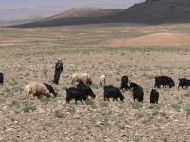Things to know about nomadic resource utilisation (continued)
Last but not least, the majority of nomadic households nowadays have access to alternative sources of income (wage labour, the gathering and selling of plants, tourism), beside their pastoral income, that factor into their decisions as well (cf. Gruschke 2011b). All these examples indicate that nomadic resource utilisation is characterised by a complex interplay of climatic, ecological and socio-economic framework conditions that have repercussions on the rangeland and its development over time. In the long term, this can adversely affect the ability of pastures to regenerate and, as a consequence, the livelihood security of nomadic households (cf. Müller et al. 2007, Gruschke 2012).
These framework conditions are anything but fixed; they are in fact exposed to substantial changes. One example is the widely discussed topic of climate change. For areas typically roamed by nomads, an increasing frequency of droughts, floods, and snow disasters has been observed or predicted (cf. Martin et al. 2014). Changes also occur in key socio-economic conditions – examples for this include the liberalisation of agricultural markets, the introduction of governmental support programmes, and increasing tendencies of rangeland acquisition up to the global phenomenon of large-scale land grabbing by transnational corporations (cf. Gertel & Breuer 2007, Gruschke 2011a).




